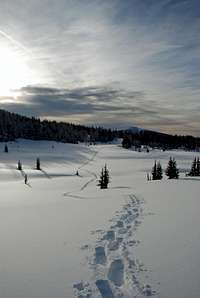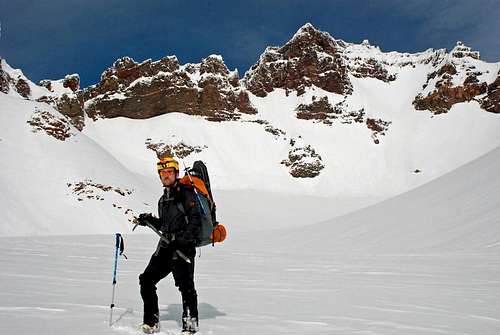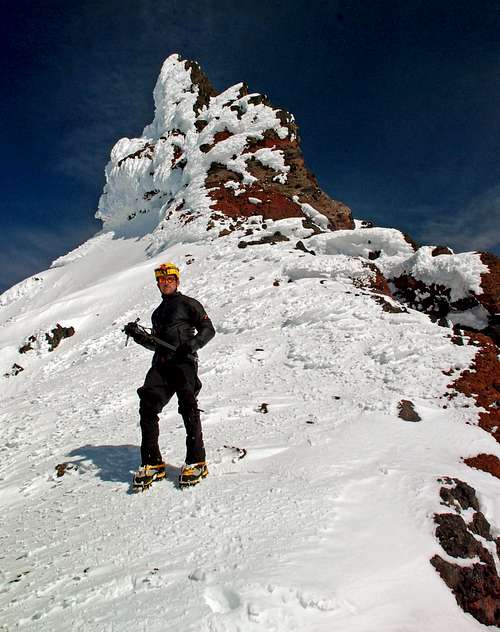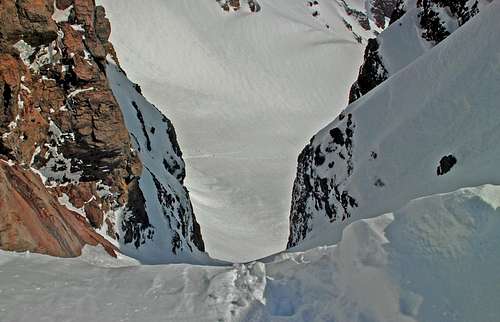Preperation
![Long approach from Dutchman Flat to Broken Top]()
Throughout December and January heavy snow had been falling in the mountains, basically limiting me to summiting peaks below 7000 feet. With soft snow, extreme avalanche danger, and long approaches, most mountains were not accessible. So with the weather moderating over the past week, and having received little snowfall I decided to try for one of the big guys again. I decided to summit Broken Top in Central Oregon, a 9175 foot tall mountain. There is an easier route which approaches from the west and climbs a long ridge. This would end up adding considerable time to my overall approach to try and snowshoe miles around to the back side of the mountain, since the only driving access stops at Mount Bachelor to the east. I decided to climb up the crook glacier and ascend the 9 o’clock couloir instead. I plotted out my route, made my itinerary, and left all info with a family member. I also will leave an emergency information packet on my windshield since I was climbing solo. I loaded up my backpack with around 40 pounds of gear, to include provisions to spend the night if needed. Now I was ready to tackle the 13.5 miles to the summit and back.
The Approach
![Headwall and summit above Glacier on Broken Top]()
![Standing at the bottom of the Crook Glacier on Broken Top]()
February, 25th, 2008 I arrived at Dutchman flat near Mount Bachelor around 5:00am. I prepared my gear, put on my mountaineering boot shells, and strapped on my snowshoes. I set out on my route using the light from my headlamp. The trail through the snow had already been made by snowshoes and skis for the first 1.5 miles, making travel fairly easy. There was around 150+ inches of snow on the ground here. I soon left the trail and had to break trail the rest of the way. The snowpack was consolidated nicely, but there was around 6 inches to a foot of fluff on top of the consolidated stuff. I traversed along a long ridge, gaining and losing elevation along the way. As I neared Ball Butte the sun was coming up and I could turn off my headlamp. I climbed up a large ridge and finally had a nice view of Broken Top poking over the trees. I had assumed that when I reached Broken Top the snow would be nice and hard, but when I got to the bottom of the crater I found a very different situation. The snow was fluff for about one to two feet down. Under this fluff was about three inches or so of hard pack and ice. Under that was consolidated, but fairly soft snow. The weather was still cool and the area I was in was still fairly shaded from clouds and the crater rim towering above. I could tell this snow wasn’t layered real well, but decided to keep going. When I finally reached the base of the Crook Glacier I stopped and melted some water using my MSR Reactor stove. I also took of the snowshoes and put on my crampons, ice axe, and helmet. While resting there, the sun was now hitting the tops of the crater rim, and I could hear chunks of ice and rocks falling.
The Ascent
![Large Snow Wheels at bottom of 9 o clock couloir on Broken Top]()
The climb begins from the bottom of Crook Glacier which sits inside the old crater of Broken Top. The glacier was covered with a thick layer of snow, maybe 150 – 200 inches I would estimate. I could see a large crevasse at the top of the glacier where it was separating from the snowpack. I work my way along the middle of the glacier, which is fairly easy travel. The whole time I hear stuff falling off the crater rim. When I reach the headwall above the glacier, I start seeing small balls of snow rolling away from the cliff face. I study the route up the headwall up to the 9 o’clock couloir. I could definitely tell that the snow was becoming more unstable with the sun now hitting it, but I came this far and wanted to summit. I began my climb up the headwall towards the couloir. I headed straight up the middle of the couloir. The snow is hard and I can get a good purchase with my crampons in some areas, and then in other areas the snow is soft with the hard stuff one to two feet below it. As I’m climbing, a barrage of large snow wheels the size of a car tire began rolling by me. Now I’m quite concerned with my situation. I’m now at the base of the couloir which is halfway up the headwall, and reach a pocket of very heavy, soft snow which is sitting on hard ice. I start having large chunks break away when I try to get a good foot hold. I decide to shimmy over to the left where I would be closer to the rock face, and maybe firmer snow. The only problem is that along this rock face there are holes which are quite deep. I choose to get in one of these holes so that I could get a little rest before climbing higher. At this time I’m getting quite tired and a little sick from over exertion and altitude. I began to climb higher into the couloir which is now very steep. The snow in the couloirs is now becoming soft and I’m basically struggling to even maintain a good foot hold. About fifty feet from the top of the couloir I get massive cramping in both my legs from the exertion put out on the approach and the intense climbing. I end up sort of dangling my legs while holding my firmly planted ice axe. I eventually just decide to push hard to the top fighting the intense pain. The snow up here is extremely soft and I have to get over a huge cornice. I get to the top and crawl on my belly to a level spot on the summit ridge where I take off my pack and lay there for nearly an hour. I’m now suffering altitude sickness badly, the worst I have ever experienced. I’m sure this is from too much exertion in one day. I’m so bad in fact that I can not complete the last 300 feet gain and 1/4 mile to the summit pinnacle. This is a traverse across the steep west slope. Now I have another big problem, how to get back down.
Planning My Escape
As I’m standing on top the mountain planning my escape, I hear what sounds like an occasional jet flying over. I soon realize these sounds are avalanches inside the crater where I just came through. At this point I’m scared to climb back down the couloir. I know this means setting off an avalanche, serious injury, or death. I can see the easier northwest ridge route, and think that maybe I can get to that. The only thing is that would add probably ten miles to my trip. I try to climb over to it anyways, but I could not get a good purchase in the hard ice on the west side of the summit ridge, and was actually losing footing. The drop on this side is huge, and a fall would be fatal. I decide to turn back and shimmy my way back to the level spot at the top of the couloir. The next idea is to dig a snow cave and spend the night, hoping the couloir would be safe to travel in the morning. The weather had called for very mild and sunny conditions all week. I had to get back to my truck by 12:00pm Wednesday or a search and rescue might be started. I notice a lot of high clouds moving in, and a west wind blowing. So now I’m thinking that something in the weather has changed and spending the night on this exposed ridge, with minimal food would be very bad. I finally get some serious balls and decides the only thing to do is to descend the couloir where I came up. This idea scares the hell out of me, but I have to do it.
![View from top of 9 o clock coulior on Broken Top]()
![Standing on the summit ridge of Broken Top]()
The Descent
I decide to descend the couloir facing out. I use my ice axe in my right hand and a trekking pole in my left. I stomp in good steps each time I step down, and have my axe and trekking pole firmly stuck in. This couloir is a steep bastard, and about 500 feet high. As I work my way down, I can now see the avalanches that have occurred around the rim. I reach the halfway point down the headwall, which is at about the bottom of the couloir. I feel the snow start to move, and now its shear panick. I decide to jettison my backpack and send it cart wheeling the 300 feet or so down the headwall. I descend a little further and the snow under me gives out, I’m caught in an avalanche. My ice axe and trekking pole are ripped out of my hands. The axe is attached to my wrist. I manage to flip onto my belly and can see my axe flying around above my head. I somehow manage to grab it and I slam my pick into the hard snow under the loose moving snow. I finally come to a stop, about 150 feet or so from the bottom. Luckily the snow that broke was only about a foot deep and was fairly isolated. I don’t know why the whole couloir didn’t break loose. I got very lucky I think. I rounded up my pack, and my GPS which had flown out of the pack. I dig out my camera and realize the $250 lens is broke. As I’m getting my gear together I hear a large explosion sound, followed by a thunderous crashing sound. I look around, terrified and see a large avalanche across the crater rim coming down into the bottom of the crater. I decide it’s time to get the hell out of here. I could count around eight avalanches that had come down around the rim. I began descending across the glacier. I get to the bottom of the glacier, and take off my climbing equipment and put my snowshoes back on. While doing this another massive avalanche comes down, falling nearly a thousand feet from the top of the rim. This avalanche about a football field wide and comes to rest about 150 – 200 yards away from me. The whole time I can still hear large rocks, snow, and ice falling around the crater rim. I can even hear waterfalls starting to form from the intense sun.
![Looking down the 9 o clock couloir on Broken Top]()
Snowshoe Trip Back
I drink the last of my water, and began my long snowshoe descent back to my truck. I’m feeling very sick and sore. I manage to eat a little bit of power bar and some gue packets on the way down. I also grab snow and eat that for water. After a long tiring snowshoe slog over varying terrain I finally reach my truck about 5:00pm. At this point I feel like I want to puke, and I’m badly dehydrated. I sit there and rest a while with the heater blazing, nursing down two bottles of water and eating a little chocolate bar and power bar. I have severe chills and shakes from the over exertion. I finally get to feeling slightly better and drive away.
Conclusion
Overall this was an exciting trip. Any winter mountaineering trip has hazards, and unpredictable elements to deal with. My wanting to summit one last big peak for the year, and not stopping when I saw conditions where worsening nearly cost me my life. I learned a lot from this trip, and it was definitely the most dangerous climb I have done, and the most physically taxing. I put a lot of planning, preparation, and thought into this trip. But the unpredictable weather conditions and snowpack played a major role in what occurred. This is an example of what can happen when you try to do a major summit in a day, instead of taking two days to do. All in all I think it was a successful trip, even though I didn’t get up the last 300 feet, but I think trying to do that would have only worsened my condition. I did reach 8794 feet, the trip took 12 hours, was 13.30 miles round trip, and had a total elevation gain of around 3000 feet. Most of the elevation gain was near the mountain.
















Comments
Post a Comment